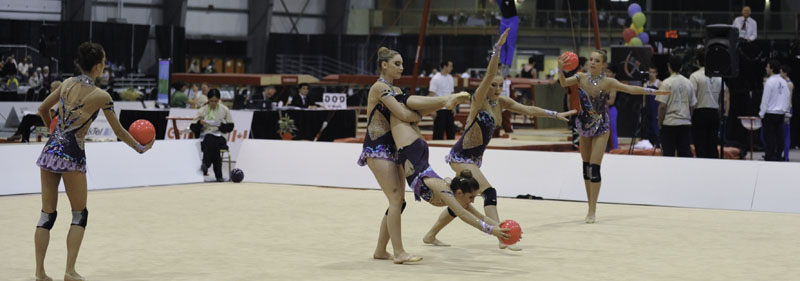
Rhythmic Gymnastics events start Thursday (CTV’s schedule). For the first time ever, Canada qualified for the group event. Thumbs up to team Canada! GO CANADA!
I have never seen rhythmic gymnastics until 1984 when Lori Fung from Canada captured the first gold. What caught my eye was the ball handling. In LHBF, we use a wooden ball to train sensitivity and circles. I have heard of how some masters can swipe a wooden ball up and down a wall and when I saw the rhythmic gymnastics’s ball handling, I thought, hey, this is very interesting! Well how time flies, that was more than 20 years ago 🙂
Rhythmic Gymnastics, like artistic gymnastics, is a judged sport using a point system. Gymnasts document their routines using special symbols representing the body and apparatus difficulties in performance sequence. The judges score what was performed against what was intended. There are 4 judging panels, each panel has 4 judges looking at the performance from a very specific perspective:
- Difficulty panel (10 points)
- D1 panel (Body) – aside from the connectors and dance steps, body difficulties that actually scores are from these body groups: jumps/leaps, balances, pivots and flexibilities. For groups, exchanges are counted and evaluated within this D1 panel.
- D2 panel (Apparatus handling and risks) – you will see the gymnast throw the apparatus high up, do some rolls and then trap it, throws without the hand, catches with the feet, rolling of the ball across the arm and chess during a jump and all kinds of crazy things and much more.
- Artistic panel (10 points)– is the gymnast perform to the music? Are there enough variety of handling, trajectory, use of floor, level, direction, planes and dynamics? are the connections flowing naturally? Is the whole body involved with the expression? For groups, formations, collaborations are also required.
- Execution (10 points) – how clean are the movements? toe pointing, extension, imprecise shape, missed catches, knots with the ribbon or rope, imprecise throws, etc will all cause deductions from a perfect score of 10.
At the Olympics, rhythmic gymnastics is a women’s only sport. Japanese’s version of men’s rhythmic gymnastics, with an emphasis on power, speed and tumbling with music and apparatus handling, is yet to be approved by FIG.
Exercise
- What do you think is common between rhythmic gymnastics and LHBF martial arts training?
- What is the advantage of using rhythmic gymnastics apparatus as a tool for LHBF martial arts training?
Individual routines – Hoop and ball from 2011 Worlds
Group routines
Team Canada at Nationals 2012 this year
Men’s individual (clubs by Kazuya Dekita)
Men’s group (non Olympic)
A routine choreographed with humor and creativity
